Learn how to ferment ginger sauerkraut with orange and sesame. With only six ingredients and some patience, you can make this flavorful sauerkraut with fresh orange, sesame seeds, and freshly grated ginger root. This wild-fermented sauerkraut contains billions of gut-healthy microorganisms, vitamins, and prebiotic fiber.
Ingredients You’ll Need to Make Ginger Sauerkraut with Orange and Sesame
- Cabbage: I suggest green cabbage for this recipe. A small head of cabbage will make about two jars of sauerkraut using this recipe. Look for a cabbage that still has outer leaves at the store. Usually, if a cabbage still has its outer leaves, it’s more hydrated and fresh, which means more brine! Yay! You are welcome to try napa cabbage in the recipe too.
- Orange Juice: Adding orange juice to this recipe was quite fun! I enjoy experimenting with small amounts of fruit added to cabbage fermentations. For this recipe, use freshly squeezed orange juice, and I also added a slice of orange to make the photography more enjoyable.
- Sesame Seeds: Sesame seeds are one of my favorite seeds. I was excited to find that a light sesame flavor developed through the fermentation process.
- Ginger: You can use dried, powdered ginger here, but I prefer freshly grated ginger in this recipe. All the flavors are so light and juicy, and fresh ginger adds a nice zing.
- Sea Salt: I like to use unrefined solar-evaporated sea salt, and any pure sea salt will do. If you like experimenting with fancy sea salt in fermentation recipes, I suggest trying French grey sea salt.
- Water: I add some water to all of my cabbage fermentation recipes, and water is still drawn out of the cabbage when salt is added. However, having water as a part of this recipe accounts for seasonal changes in produce hydration levels. So no matter where you are in the world or what your cabbage is like, you should have success with this recipe.
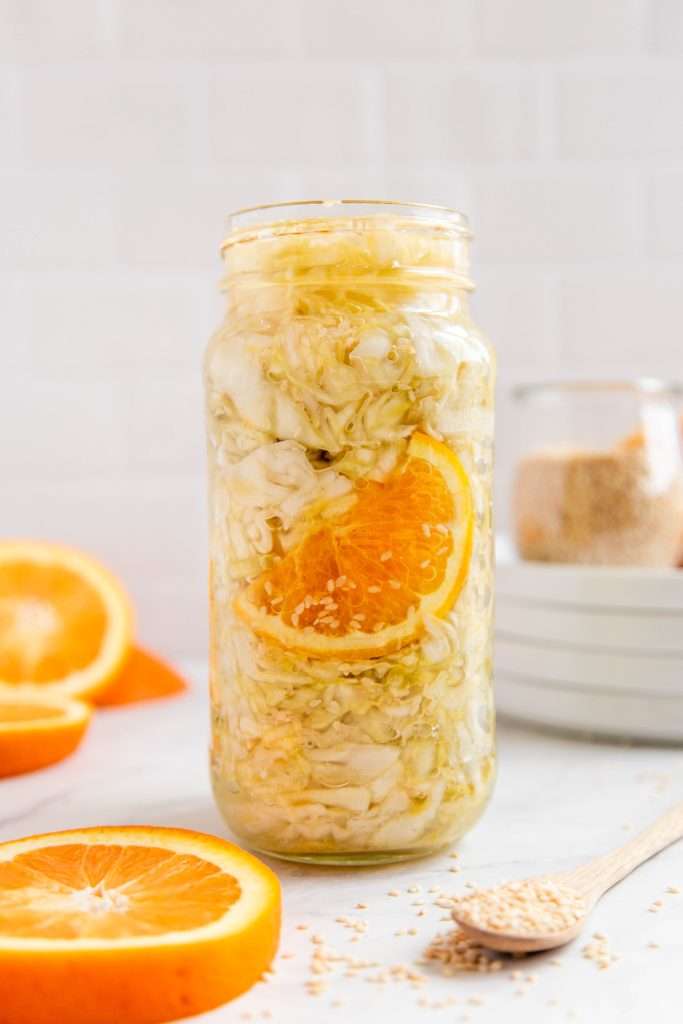
Using Fruit Juice in Ginger Sauerkraut
I write a lot about food safety and fermentation on our blog. Generally, the more sugar in the starting ingredients for fermentation, the less likely you’ll have successful lactic acid fermentation.
Through extensive recipe development and testing, I’ve found that it’s best only to incorporate fruit into cabbage-based fermentation projects. The first reason is that the cabbage microbiome is phenomenal for wild fermentation and balances out any addition of fruit sugars.
Secondly, I’ve found that if the fruit or fruit juice only makes up 1/4 of the ingredients (by mass), then the fermentation microbiome doesn’t vary by much from cabbage ferments without fruit.
Supplies You’ll Need to Ferment Ginger Sauerkraut
- 32 ounce Wide Mouth Mason Jar
- Fermentation Weight
- Standard Metal Mason Jar Lid (this can rust in the presence of salt)
- OR Rust Free Plastic Lid
- or you can use a Weck Jar (without the gasket; only use the clips to secure the lid)
- Sea Salt
- Scale
- Mixing Bowl

How to Ferment Sauerkraut with Orange, Sesame, and Ginger
During the first few days of fermentation: carbon dioxide and bubbles will be produced. Sometimes, jars will become full of liquid, and this liquid can seep out.
- If using a standard mason jar lid: remove the lid and tamper everything back down using a gloved hand, tamper, or spoon. Ensure everything, including the weight, is submerged below the brine.
Always Trust your sense of smell: Fermented cabbage should smell pleasantly sour and like strong cabbage. Never eat anything that smells repulsive or yeasty.
Never eat anything that has mold growing on it: By following directions, you should not encounter this problem.
Taste test at three weeks: If you prefer the sauerkraut to be more tart and sour, you can let it ferment for four weeks.
What Temperature Should I Keep My Sauerkraut at While it Ferments?
Keep your fermenting cabbage at a temperature between 70-80 degrees F. Keep out of direct sunlight
How Long Should I Ferment My Homemade Sauerkraut?
After three weeks, remove the fermentation weight and smell and taste test. Your fermented cabbage should smell pleasantly sour and taste tart, lightly salty, and cabbagey.
Do I Need to Refrigerate Sauerkraut?
After fermenting for three weeks, remove the weight, place a regular mason jar lid on the jar, and refrigerate. Consume within six months for full probiotic benefits.
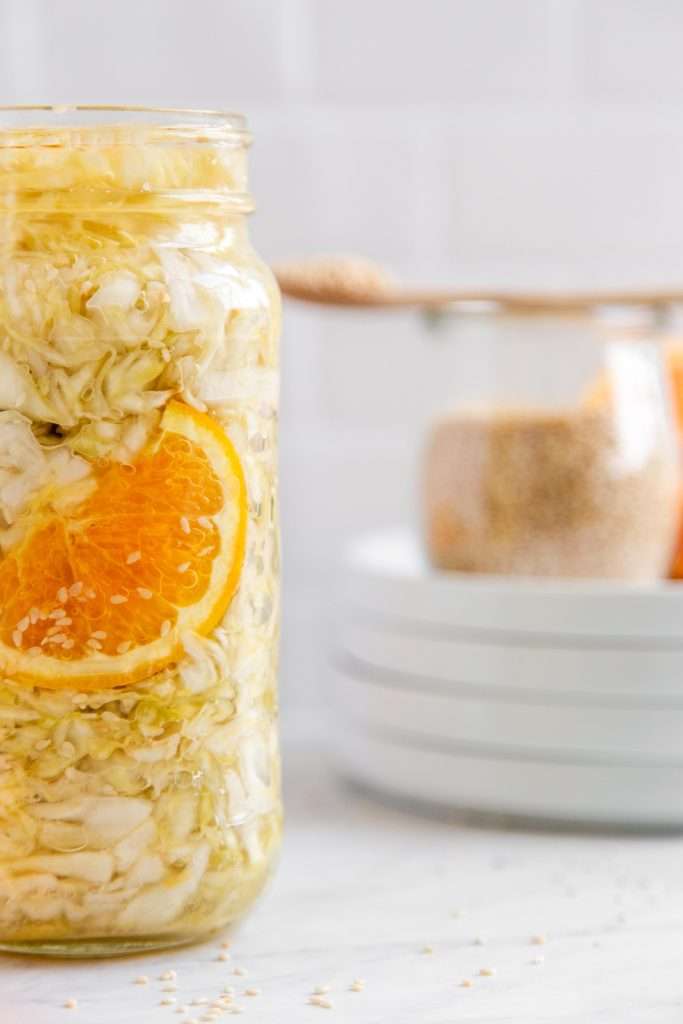
Ginger Sauerkraut with Orange and Sesame
If you follow our recipe and directions, your timeline of sauerkraut fermentation should approximately match ours.
24 – 48 hours: All contents in the jar should be submerged beneath the brine. At this time, Gram-negative bacteria and possible pathogens are still present.
48 hours – 5 days: After 48 hours, you should start to see lots of bubbles being produced. This is when the ferment enters stage two of vegetable fermentation, Leuconostoc bacteria begin to thrive, and Gram negative organisms die off by day 5.
5 – 10 days: The bubbles in the brine will decrease as the ferment leaves stage two and enters stage three. The ferment will become cloudy, the color will change, and a pleasant sour smell will develop. Lactobacillus species begin to thrive in this period. Sometimes Leuconostoc bacteria can thrive and produce bubbles up to 14 days into fermentation.
10 – 21 days: Lactobacillus comprise most or all microbial populations. They produce copious amounts of lactic acid, making the fermented cabbage smell even more pleasantly sour. This is when the vegetable mixture becomes sauerkraut and is preserved.
More Sauerkraut Recipes to Try
- How to Ferment Sauerkraut in a Mason Jar
- Fermented Beet and Red Cabbage Sauerkraut
- Roasted Garlic Sauerkraut with Black Pepper


Fermented Ginger Sauerkraut with Orange and Sesame
Learn how to ferment ginger sauerkraut with orange and sesame. With only six ingredients and some patience, you can make this flavorful sauerkraut with fresh orange, sesame seeds, and freshly grated ginger root. This wild-fermented sauerkraut contains billions of gut-healthy microorganisms, vitamins, and prebiotic fiber.
- Prep: 15 Minutes
- Cook: 0 Minutes
- Total Time: 15 Minutes
Ingredients
- 500 grams green cabbage
- 20 grams unrefined sea salt
- 150 grams filtered water
- 20 Grams Ginger, Grated
- 2 Teaspoons Sesame Seeds
- 50 Grams Orange Juice, Freshly Squeezed
Instructions
- Wash your fermentation equipment (jar, weight, and lid). For this recipe, I suggest sterilizing the jar, lid, and weight with a little bit of vodka.
- Remove the outer leaves of your cabbage and lightly rinse with cool water. Using a knife, chop the cabbage to your desired thickness.
- Place your kitchen scale on the counter. Turn it on and set it to weigh in grams.
- Place a mixing bowl on your kitchen scale and tare/zero the scale.*
- Add the designated amounts of chopped cabbage, ginger, sesame seeds, and orange juice into the bowl.
- Remove the bowl of cabbage from the scale and set aside. Place a small, empty bowl on your scale and tare/zero the scale. Weigh out 20 grams of salt.
- Add the salt into the bowl with the cabbage, and mix with your clean hands. I mixed for about two minutes.
- Place your empty, clean mason jar on the scale, and tare/zero the scale. Make sure your scale is still set to grams and add 150 grams of filtered water to your mason jar.
- Add the water into the bowl with the cabbage. Mix everything well for about 2 minutes.
- Starting with the liquid, add the entire contents of the bowl into your mason jar, and pack everything down using a tamper, wooden spoon, or your hand.
- Place your glass fermentation weight in the jar, making sure to submerge the cabbage pieces and weight fully into the liquid. If you don’t have quite enough liquid, place your glass fermentation weight in the jar and submerge as much a possible. Over the next 12 hours, the cabbage should release more liquid and you can press down your fermentation weight below the brine.
- Secure the solid lid to the jar. You do not need to tighten it all the way. Just secure the lid but leave it ever so slightly loose, so the gas doesn’t build up too much.
- Ferment for 21-28 days, then remove the weight and refrigerate. Don’t forget to burp the jar daily during the bubbly phase, making sure everything stays submerged.
- If you try this recipe and love it, please leave a five-star review below!
Notes
This recipe works best with a 20-32 ounce jar
*Taring/zeroing the scale with a container on it subtracts the weight of the container, allowing you to weigh only what is added to the container. After taring/zeroing the scale, it should read 0.0 with the container on it.
100 grams water = 100 mL water
I only added an orange slice for decoration. You can do the same without adjusting the recipe.






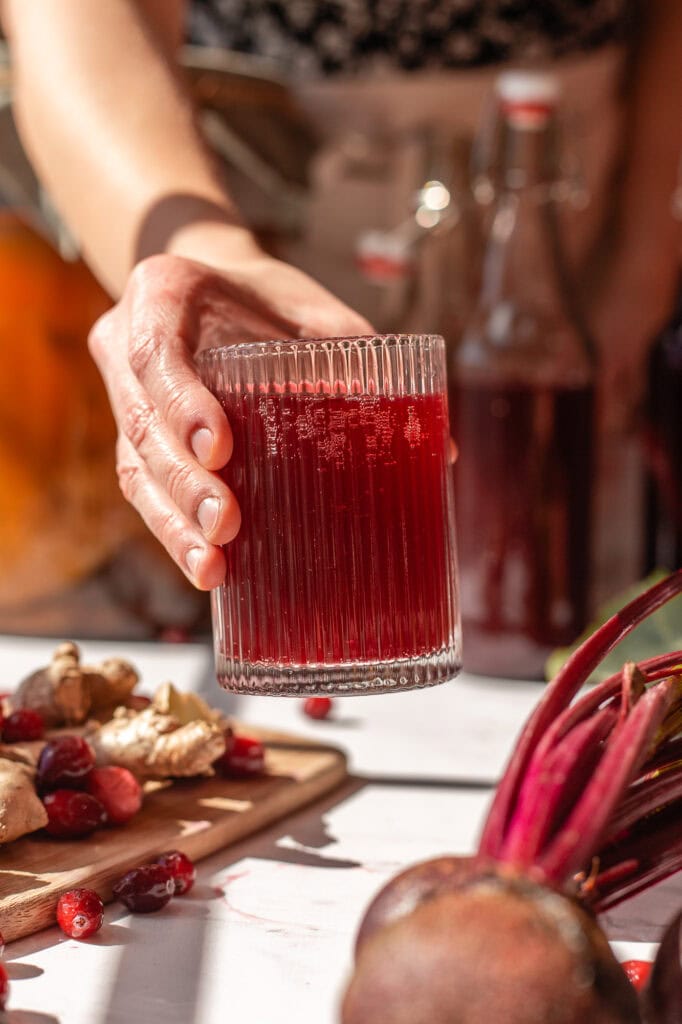










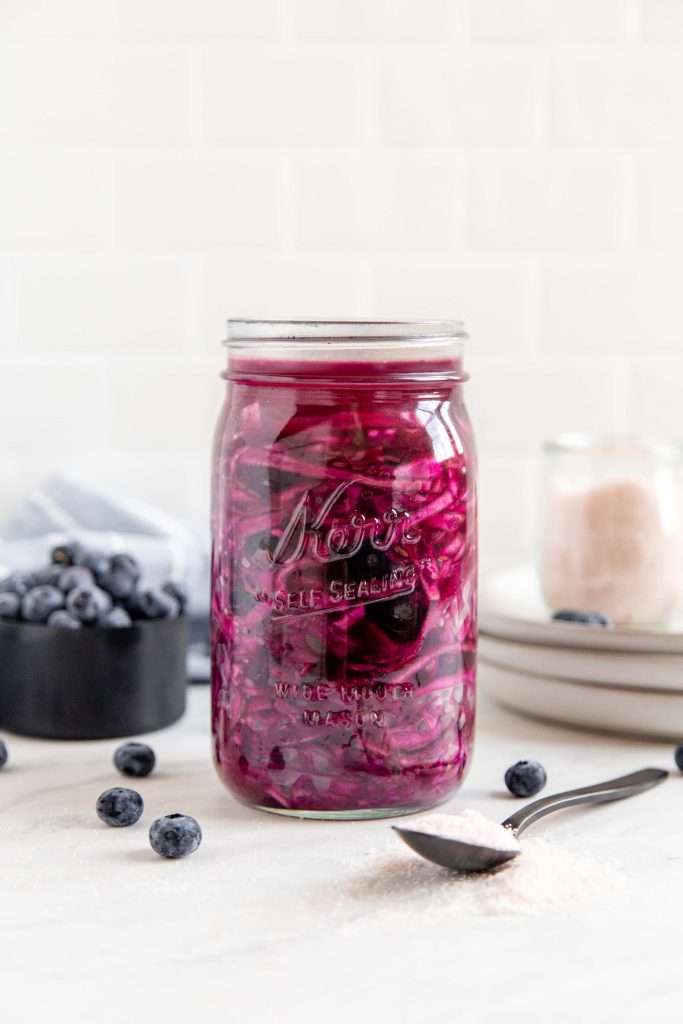
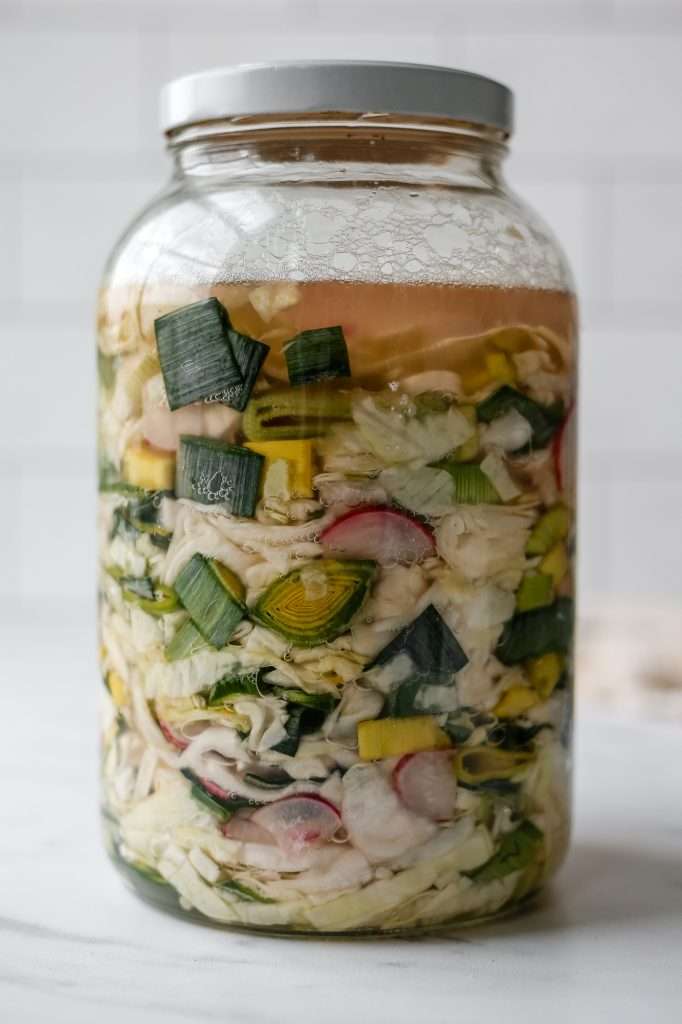


This is brilliant! I’m a huge fan of sauerkraut, but the last time I tried to make it they came out really sour. I’m excited to try this recipe! Thank you for sharing!
Just made this recipe and I’m so excited to try it! The recipe was super easy to follow and I really appreciate the extra explanations & timeline within the blog post too!
Thank you for sharing 😊
Update— the first time I made it I used one of those silicone fermentation lids and it got contaminated :/
So the second time opted for a regular lid with a rust free band and it turned out wonderful! Seriously, so good! Never thought I’d be such a big sauerkraut fan, but here I am trying allllll your recipes.
So thank you, thank you, thank you! 🖤
Hi! I am trying the amazing looking recipie!
I dont see orange slices in the recipiec though, just on pictures. Is it okay to add a couple without adjusting salt ?
I only added that for decoration! You can add a couple without adjusting the recipe.
Hello,
This looks and sounds delicious. Can I make this in a fermenting crock? Thank you.
sure, but you may need to double or triple the recipe depending on the size of your crock.
I have a question: I have read on many homepages, on YouTube and in my fermentation book that the amount of salt for sauerkraut is 2% of the weight of the cabbage. In the case of 500 g of cabbage that would be 10 g of salt not 20 g as you have written. Isn’t that too much salt?
I write my own recipes, and I’m happy my recipes are unique. For sauerkraut I advise 2.5% total salt. So 2.5% of the cabbage, any other fresh ingredients, AND water (and in this case orange juice). so no, it’s not too much, it’s 2.5%.